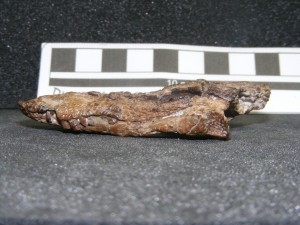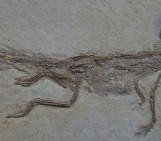The Natural History Museum in London contains some of the most diverse vertebrate Palaeontological collections in the world, in terms of number of species. As part of my PhD, I have to learn detailed crocodile anatomy, mostly skeletal (osteology), to help identify and describe the particular group I’ll be researching into. The Zoology Department would normally be a great target to go and learn this, but for reasons undisclosed, they were unavailable for research visits. Fortunately, Lorna Steel, a curator of the fossil vertebrates, informed me that they had some extant croc material I could come and play with! Seeing as Imperial College is next door to the NHM, I trotted off to have a peak.
Lorna had a pretty cool caiman skeleton to hand, nearly complete, but mixed in with an assortment of other elements from different crocs. Nonetheless, it was quite a worthy practice croc, and I used it to learn the structures and relative positions of the skull bones, as well as how the limb bones differ in their subtle ways. As crocodiles are quadrupedal (please inform if you have evidence that this is not the case!), their limb bones are quite convergent in appearance, and as such, it’s quite difficult to tell some of the elements apart, to the less-experienced eye. For example, the fibula (shin) and radius (forearm) are pretty featureless bones, relatively, and look nearly identical in crocodiles (compared to my previous experience with ornithopod dinosaurs, anyway). It’s a learning curve, as with all research. Some photos of these specimens can be found below (mostly skulls, as they were the coolest parts!)
As well as the extant material, Lorna also showed me some of the material from the British Purbeck Formation (Upper Jurassic). I knew that one of my target species, Theriosuchus pusillus, was hiding in the collections somewhere, and surprisingly there were at least 5 draws full of material! Theriosuchus is an atoposaurid crocodylomorph, and rather cutely only about 15 inches long as a fully grown adult (they were dwarf crocs!) If the group wasn’t extinct, they’d make perfect pets. Part of my project will be revising the taxonomy and relative phylogenetic position of this poorly-known group, which is quite fortunate seeing as currently known specimens are anywhere from Europe to Thailand. Naturally, the NHM’s Theriosuchus specimens could not be ignored!

The most complete specimen of Theriosuchus pussilus at the NHM (dorsal aspect). It’s pretty! (click for larger) Copyright: Natural History Museum
One thing I found odd about the material, is that it seemed to be dominated by jaw fragments, and scutes, or osteoderms, the crocodiles’ external body armour. There was little, classified as Theriosuchus, in terms of appendicular elements (limb bones, shoulder and pelvic girdles). In the Purbeck Formation, there are other crocs too, such as Nannosuchus and a group known as goniopholids. Pretty much all of the appendicular material had been classified as indeterminable goniopholid. This demonstrates that the group Goniopholididae is almost a ‘wastebin taxon’, where unidentifiable material is assigned to it without detailed inspection. It also shows that the Purbeck crocodiles were extremely similar in appendicular morphology, to the extent that the individual bones were not diagnostic to any particular species or even genus. This explains why none of the material (and there was a lot) had been assigned to Theriosuchus. I’ll probably go in at some point and take a closer look at this, seeing as it might help provide clues as to why, allegedly, you can have three different crocodiles co-existing with each other. I’m also in the process of sketching the specimens for professional reproduction – you can have a laugh at them on here when I’m done with them!





Ross Mounce (@rmounce)
Since when has the NHM been enlightened and allowed people to post images of specimens on the internet(?)
Did you get given these images, or did you photograph them yourself? (I’d be pleasantly surprised if it’s the latter!)
Kudos anyhow 🙂
tennant
Photo’d them myself. Double checked with Paul, and he said it was ok seeing as it’s just a blog, and there’s probably not a policy covering that (needs to be investigated)
Mike Taylor
Ross, see the SV-POW! post on NHM photos: http://svpow.com/2008/01/11/credit-where-its-due/
Lorna Steel
Evening all! There is a copyright form that visitors sign to declare that their own photos of NHM specimens will be used for non-commercial academic / personal use only. Unfortunately the curators have enough visitor-related bureocracy to deal with already, so the copyright form sometimes gets forgotten, as does the Health and Safety form. And don’t even mention the loan forms and the sampling applications…
Photos taken by visitors are added to the specimen database, so please make sure they are in focus! 🙂
tennant
Oh yeah! I’ll create a DVD/CD and pass it along when I next get the chance – cheers Lorna 🙂